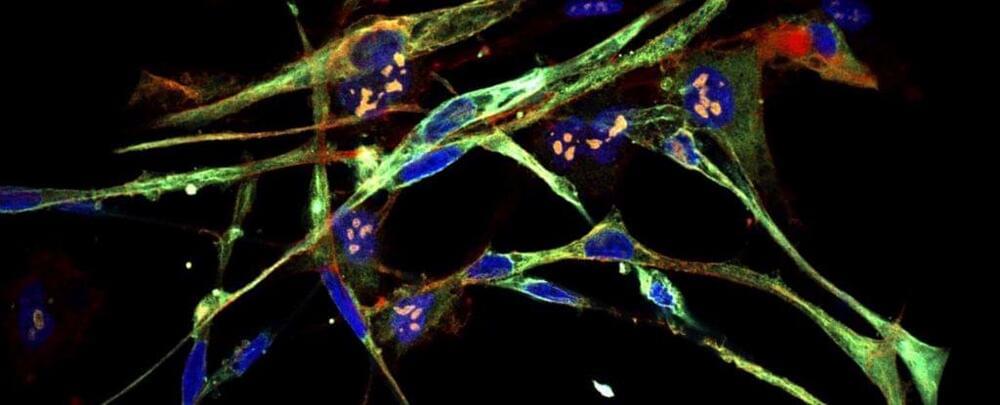Inspired by a speculative article by H G Wells and adapted from a poem in humor magazine “Punch.”
Support this channel on Patreon: https://www.patreon.com/LoneAnimator.
Support this channel on Ko-Fi: https://ko-fi.com/richardsvensson
Inspired by a speculative article by H G Wells and adapted from a poem in humor magazine “Punch.”
Support this channel on Patreon: https://www.patreon.com/LoneAnimator.
Support this channel on Ko-Fi: https://ko-fi.com/richardsvensson

Researchers from Cornell University have identified a new state of matter in candidate topological superconductors, a discovery that may have far-reaching implications for both condensed matter physics and the fields of quantum computing.
Performing computation using quantum-mechanical phenomena such as superposition and entanglement.



This is good news! The article says this could lead to treatment of other cancers.
A particularly aggressive form of childhood cancer that forms in muscle tissue might have a new treatment option on the horizon.
Scientists have successfully induced rhabdomyosarcoma cells to transform into normal, healthy muscle cells. It’s a breakthrough that could see the development of new therapies for the cruel disease, and it could lead to similar breakthroughs for other types of human cancers.
“The cells literally turn into muscle,” says molecular biologist Christopher Vakoc of Cold Spring Harbor Laboratory.
#ted.
#wifi.
#internet.
What about 102,400 MBPS or 100GBPS. This is the speed of data transfer that you can achieve with LiFi Technology. With LiFi you can download 100 movies in just one second.
How’s this incredible internet speed possible?
It is possible with LED lights.
Watch this video till the end for a detailed introduction and truths of LiFi technology.
NEW HERE! TRY THIS STUFF
▀▀▀▀▀▀▀▀▀▀▀▀▀▀▀▀▀▀▀▀▀▀▀▀▀▀▀▀▀▀▀▀▀
Warp Drive Technology.
Eye as a Camera.
- https://www.youtube.com/watch?v=3Ur6HoAN3Vo.
Artificial Blood.
- https://www.youtube.com/watch?v=MX3LU0ClFPw&t=24s.
Wireless Electricity.
- https://www.youtube.com/watch?v=zGna5lTkBuc&t=65s.
📑 REFERENCES:
▀▀▀▀▀▀▀▀▀▀▀▀▀▀▀▀▀▀▀▀▀▀▀▀▀▀▀▀▀▀▀▀▀
[1] The Technology of LiFi — E Ramadhani and G P Mahardika 2018 IOP Conf. Ser.: Mater. Sci. Eng. 325 012013
- https://bit.ly/3yMqSK9
[2] How Wireless Communication Works.
- https://bit.ly/3uUZZmq.
[3] Spectrum Crunch FAQ
- https://bit.ly/3AUCz47
[4] A Review Paper on LiFi Technology — Volume 5, Issue 23, International Journal of Engineering Research & Technology (IJERT)
- https://bit.ly/3yCAEP6
[5] LiFi Study Paper Approved.
- https://bit.ly/3uOHLCL
[6] LiFi vs WiFI
- https://bit.ly/3II3zWt.
[7] LiFi Pros and Cons.
- https://bit.ly/3oaPsQd.
[8] How Does LiFi Work?
- https://bit.ly/3o8t3De.
[9] What is LiFi?
- https://bit.ly/3aJam5P
[10] LiFi Wikipedia.
- https://bit.ly/3cmhe9u.
WHO ARE WE?

Rohit Chikkaraddy/ University of Birmingham.
Mid-infrared, as the name suggests, lies between the infrared spectrum’s near and far wavelengths, just outside those of visible light. The mid-infrared spectrum has gained particular importance as it has been useful for multiple applications ranging from military to environmental and medical treatments and studying celestial objects.
Together we are unbeatable and we will do the impossible.
Provided to youtube by universal music group.
We’re in this together · nine inch nails.
The Fragile.
℗ 1999 Interscope Records.
1 Department of Biotechnology, School of Science, GITAM (Deemed to be University), Visakhapatnam, Andhra Pradesh, 530,045, India; 2 Department of Cell and Developmental Biology, University of Illinois at Urbana-Champaign, Urbana, IL, 61,801, USA
Correspondence: Sireesha V Garimella; Pankaj Chaturvedi, Email [email protected]; [email protected]
Abstract: Cancer continues to rank among the world’s leading causes of mortality despite advancements in treatment. Cancer stem cells, which can self-renew, are present in low abundance and contribute significantly to tumor recurrence, tumorigenicity, and drug resistance to various therapies. The drug resistance observed in cancer stem cells is attributed to several factors, such as cellular quiescence, dormancy, elevated aldehyde dehydrogenase activity, apoptosis evasion mechanisms, high expression of drug efflux pumps, protective vascular niche, enhanced DNA damage response, scavenging of reactive oxygen species, hypoxic stability, and stemness-related signaling pathways. Multiple studies have shown that mitochondria play a pivotal role in conferring drug resistance to cancer stem cells, through mitochondrial biogenesis, metabolism, and dynamics. A better understanding of how mitochondria contribute to tumorigenesis, heterogeneity, and drug resistance could lead to the development of innovative cancer treatments.

Russia’s space agency on Tuesday said that the crew stuck on the International Space Station because of a damaged capsule were now expected to return to Earth in September, a year after they first launched into orbit.
Russian cosmonauts Dmitry Petelin and Sergei Prokopyev and NASA astronaut Frank Rubio flew to the ISS in September 2022 aboard a Soyuz MS-22 capsule.
They were scheduled to return home in the same spacecraft, but it began leaking coolant in mid-December after being hit by what US and Russian space officials believe was a tiny space rock.